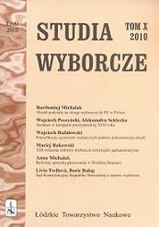Rola sondaży w polskiej kampanii prezydenckiej w 2010 roku
ROLE OF POLLS IN POLISH PRESIDENTIAL ELECTION CAMPAIGN IN 2010
Author(s): Wojciech Peszyński, Aleksandra SekleckaSubject(s): Politics / Political Sciences
Published by: Łódzkie Towarzystwo Naukowe
Summary/Abstract: The Polish presidential election of 2010 was exceptional due to events, which constituted the background of the campaign. The medial discourse was dominated by plane crash April, 10 (when the Polish President, Lech Kaczyński, died) and lather tremendous flood. The winner of this election was Bronisław Komorowski. However, more candidates achieved their political aims. The number of votes collected by Jarosław Kaczyński gave good chance for his success in the next parliamentary election in 2011. Grzegorz Napieralski, on the other hand, improved his position as the president of Left Political Alliance. His result gives his party chance to strengthen his position the next parliamentary election. What is worth paying attention to is particularly high turnout (54,94% in first round and 55,31% in second round), which is even surprising as the election took place during holidays. The polls were not most important components of this election, but it constituted the subject of public debate. According to researches kinds of the poll effect can be pointed. The case of Napieralski proved “momentum effect”. In the begging his campaign support for him equal between 3% and 4%. Due to his high activity and his being favored by Public Television, he increased his polls ratings and achieved good result in election. On the other hand the support for remainder candidates fluctuated around the statistical error. They did not improve their ratings and seven candidates achieved together 8,32%. The comparison of polls and real results of first round showed clearly discrepancies. In all polls Komorowski was getting higher results than in the real election in first round. However, in all polls Napieralski was getting smaller results than in the real election. These discrepancies were caused by the method of the research – telephone interview (CATI). The same cause occurred in late polls, which were carried out, in the day of election. Their results differed significantly from especially real results in the next round. The use of such methods in the day of election in highly risky. However, exit poll of TNS OBOP could boast high probability, especially in the second round. This allows to expect that in next election all popular televisions will order this poll. Incorrectness of polls in this campaign will not influence their position in next election. Some poll institutions will not except orders from political parties because they would like to avoid being accused of manipulation. Also the papers will not change their attitude and will not give all information about methodology of researches. In campaign in 2010 appeared the problem of breaking election silence by the users of the internet. In the day of election they informed about the results of exit poll. They avoided official bans through using sport terminology to speak of the results of voting. Because of that representatives of Political science wanted to talk about liquidation election silence.
Journal: Studia Wyborcze
- Issue Year: 2010
- Issue No: 10
- Page Range: 27-46
- Page Count: 20
- Language: Polish

